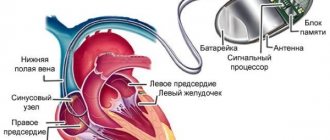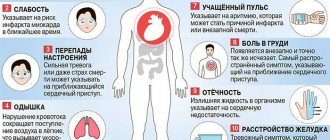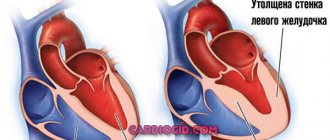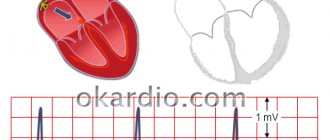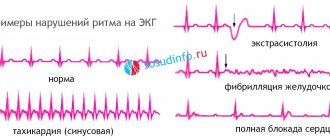Pacemaker
(EX; artificial pacemaker (IVR)) is a medical device designed to influence the rhythm of the heart. The main task of a pacemaker is to maintain or impose a heart rate on a patient whose heart is not beating fast enough or who has an electrophysiological disconnection between the atria and ventricles (atrioventricular block). There are also special (diagnostic) external pacemakers for performing stress functional tests. Any patient with a pacemaker must follow certain restrictions. What are the restrictions for patients with a pacemaker? Read the memo on the rules of behavior for a patient with a pacemaker.
Sport. Exercise stress
Patients with pacemakers can engage in any kind of sports if there are no health restrictions.
Always follow your doctor's recommendations to return to normal physical activity. Your doctor will agree with you what activities you can do during the day in order to gradually return to a full life.
Exercise is good for your heart and you will be encouraged to lead an active lifestyle. You should discuss with your doctor what restrictions exist and how to properly increase your physical activity.
Sports and exercises to avoid:
• Contact sports (such as karate or football).
• Diving.
• Shooting from a shotgun or rifle. Do not place the butt of a gun on the shoulder area where the pacemaker is implanted. The recoil of the shot may cause injury to the superficial tissue over your pacemaker.
WARNING : Avoid exercises and activities that may cause shock to the area of the implanted pacemaker. The impact will generally not cause damage to your device, but it may damage the tissue above the pacemaker.
Avoid direct exposure of the implanted pacemaker area to sunlight. Be sure to wear at least a T-shirt or other clothing to shield the area.
Return to work
An implantable pacemaker should not interfere with your work activities, except in special circumstances. Since each workplace differs in the type and direction of work activity, there are no uniform recommendations.
You will need to tell your doctor if your work activity involves the following equipment:
• High voltage electrical equipment.
• Strong magnets used in industrial areas.
• Radar or other sources of strong electromagnetic interference.
Most of the various instruments, equipment and devices around us at home or in the workplace do not affect the operation of the pacemaker and can be used with minimal or no precautions. Modern pacemakers are quite well protected from external magnetic, electrical and electromagnetic influences encountered in everyday life. However, some devices containing electrical and magnetic components may interfere with the function of the pacemaker.
An electromagnetic field is generated around devices and objects containing electrical and/or magnetic components. A strong electromagnetic field can interfere with the normal functioning of the pacemaker, resulting in inadequate - under or over - stimulation of the heart.
If you experience dizziness, rapid or irregular heartbeat caused by any external equipment on your pacemaker, simply quickly move away from it to a safe distance. Your pacemaker will immediately resume normal operation.
Types of pacemakers
A pacemaker is an electronic device that generates electrical impulses using a special circuit. In addition to the circuit, it contains a battery that supplies energy to the device and thin wires-electrodes.
There are different types of heart pacemakers:
single-chamber, which are capable of stimulating only one chamber - the ventricle or atrium; dual-chamber, which can stimulate two cardiac chambers: both the ventricle and the atrium; Three-chamber pacemakers are required for patients with heart failure, as well as in the presence of ventricular fibrillation, ventricular tachycardia and other life-threatening types of arrhythmias.
Trips
Your pacemaker does not limit your movement, and you can plan your trips for a long period of time.
Be sure to present your identification (patient card) at checkpoints at airports and train stations where magnetic screening is carried out. You must show your ID so that you can undergo a manual search if necessary.
If you are planning a vacation, be sure to make sure your insurance company understands that you have a pacemaker implanted. Many insurance companies may refuse to insure your life, much less pay for your treatment, because, in their opinion, you are at high risk. To resolve many problems, you should bring a certificate from a cardiologist stating your health status and that you are allowed to travel.
Be sure to resolve all these issues when applying for your insurance and do not postpone solving this problem until later, when an emergency has already occurred.
Types of IVR
Depending on the diagnosis, the cardiologist selects a model that will work best in the body of a given person.
The main types are external, temporary and implantable.
A temporary one is placed if necessary to level the pulse very quickly (in case of myocardial infarction, in certain types of bradycardia). It is also used for diagnostic procedures and before implantation of permanent IVR.
Cardiologists install an external pacemaker to restore rhythm for various conditions without surgery. Large electrodes are attached to the skin of the chest and back.
Implantable pacemakers are single-chamber, two-chamber, and three-chamber.
- The wires of the single-chamber model conduct the impulse from the generator to the right ventricle.
- In a two-chamber device, the impulse goes to the right atrium and right ventricle.
- In three-chamber models, the signal is conducted to the atrium and both ventricles.
The costs of installing an IVR include its cost, the cost of surgery and hospital stay. For people undergoing treatment outside the quota and choosing expensive models, the price ranges from 60 to 800 thousand rubles.
Basic rules of conduct for a patient with a pacemaker
Any patient with a pacemaker must observe certain restrictions:
- It is prohibited to be exposed to powerful magnetic and electromagnetic fields, microwave fields, as well as direct exposure to any magnets near the implantation site;
- Do not be exposed to electric current;
- Magnetic resonance imaging (MRI) is prohibited. In 2011, several stimulation systems entered the market that allow MRI to be performed under certain conditions;
- it is prohibited to use most methods of physiotherapy (warming up, magnetic therapy, etc.) and many cosmetic interventions associated with electrical influence (the specific list should be checked with doctors);
- It is prohibited to conduct an ultrasound examination (ultrasound) with the beam directed at the stimulator body;
- It is prohibited to strike the chest in the area where the stimulator is implanted, or try to dislodge the device under the skin;
- It is prohibited to use monopolar electrocoagulation during surgical interventions (including endoscopic), the use of bipolar coagulation should be limited as much as possible, ideally not used at all.
It is advisable not to bring a mobile or other wireless phone closer than 20-30 cm to the stimulator; you should hold it in your other hand. It is also better to place the audio player not close to the stimulator. You can use a computer and similar devices, including portable ones. Any x-ray examination can be performed, including computed tomography (CT).
You can work around the house or on the site, use tools, including power tools, provided they are in good working order (so that there is no risk of electric shock). The use of rotary hammers and electric drills, as well as lawn mowers, should be limited. Mowing and chopping wood by hand should be done with caution and should be avoided if possible.
You can engage in physical education and sports, avoiding contact-traumatic types and avoiding the above-mentioned mechanical impact on the stimulator area. Large loads on the shoulder girdle are undesirable. In the first 1-3 months after implantation, it is advisable to limit movements of the arm on the implantation side, avoiding sudden lifts above the horizontal line and sudden abductions to the side. After 2 months, these restrictions are usually lifted. Swimming is permitted.
Controls in stores and airports (“frameworks”) cannot spoil the stimulator, but it is advisable either not to go through them at all (for which you need to show the pacemaker owner’s card to security), or to reduce your stay in their area of effect to a minimum.
A patient with a pacemaker must visit a doctor promptly to have the device checked using a programmer. It is highly advisable to know about yourself: the brand (name) of the implanted device, the date and reason for implantation.
Conditions requiring device implantation
An artificial pacemaker (APM) is placed on people with severe cardiac pathologies, and indications for installation can be absolute and relative.
The absolute ones include:
- bradycardia (slow heart rate), in which the pulse is not higher than 40 beats per minute during exercise;
- Morgagni-Adam-Stokes syndrome (fainting due to cerebral ischemia developing as a result of a sharp disturbance in the heartbeat);
- atrioventricular (AV) heart block of 2 and 3 degrees (only part of the electrical signals pass inside the myocardium or they are absent);
- atrioventricular block 2, 3 degrees after a heart attack.
Relative readings:
- asymptomatic 2nd degree AV block,
- 1st degree atrioventricular block (slow conduction of currents from the upper chambers to the lower) or 2nd degree with symptoms of pacemaker syndrome (fatigue, weakness, chest pain, difficulty breathing),
- some types of 1st degree AV block,
- severe heart failure.
Diagnostic and therapeutic procedures contraindicated with a pacemaker
Some medical procedures can interfere with the pacemaker's function.
Accordingly, they cannot be performed on a patient who has an implanted pacemaker. Here is a list of these procedures: 1. During any surgical operation - electrosurgical instruments: electrocoagulator, electric scalpel, etc. If electrosurgery is necessary, then: - it is advisable to use bipolar systems; -discharges should be applied in short bursts; -minimum energy values should be used; -exposure time should be as short as possible; - the distance from the CS should be as large as possible; - the indifferent pole must be located in such a way that the intensity of the current passing through the stimulation system is minimal; -the operation is recommended to be carried out under ECG control. -If possible, immediately before surgery, send the patient to reprogram the pacemaker to VOO mode - this will eliminate the risk of stopping the pacemaker during the shock. The stimulation system should be checked after surgery. 2. Diathermy. 3. Lithotripsy. 4. Radiation therapy using equipment that emits ionizing radiation (such as linear accelerators and devices that use radioactive cobalt - “ROKUS”, “AGAT”) 5. Physiotherapeutic procedures using short-wave radiation. 6. Magnetic resonance imaging (MRI), previously called Nuclear Magnetic Resonance (NMR) 7. Ultrasound therapy near the pacemaker and in the projection of the electrode. Ultrasound examination is not contraindicated. 8. Transcutaneous nerve stimulation. 9. Electronic alarm systems (in shops, airports, etc.) It is recommended to pass through such areas as quickly as possible and not linger in them. 10. Defibrillation. The CS provides protection against defibrillator discharge. However, after defibrillation, the CS must be checked, since the program may change as a result of high-energy shocks. As a result of a defibrillator discharge, a high current may occur at the tip of the stimulating electrode, which can lead to thermal damage to the myocardium (possibly increasing the stimulation threshold!!!). To avoid this, the defibrillator electrodes should be positioned in such a way as to reduce the passage of current between the CS and the heart. Defibrillator electrodes should not be placed directly above the CS or along the implanted electrodes.
Save on social networks:
Rules of life after installation of a pacemaker: how it goes, how long it lasts
A pacemaker (pacemaker) can eliminate the symptoms of many heart diseases (for example, arrhythmias or bradycardia). The device combats the consequences of an abnormal heart rhythm, but does not eliminate the pathology that caused the failure. However, the device allows the patient to live a full life, provided that the patient complies with the restrictions and rules associated with its installation.
When to replace
It is difficult to say with certainty how long a pacemaker will last. On average, its service life is from 5 to 7 years. There are cases when replacement is carried out earlier or later. The operating time of the device is affected by:
- Type of installed device. Devices that operate continuously are replaced earlier than their “smart” counterparts, which turn on only when necessary. Some modern models last about 14 years.
- Battery Type. The more powerful the battery, the less often it is replaced.
- Unforeseen disruptions in the operation of the CS. Failure to comply with restrictions after surgery sometimes results in the device having to be reconfigured or replaced.
- The diagnosis given to the patient. The more chambers of the heart the CS stimulates, the more intense its work and the shorter its service life.
- Emerging complications. Inflammation sometimes appears at the installation site of the device. If the case is severe, the pacemaker is urgently removed or replaced, even though it would have lasted a long time. Most often, the cause of inflammation lies in the displacement of the device under the skin or infection.
- Critical conditions. The device is removed if there is a need to perform surgery (for example, as a result of an injury), and the CS does not allow assistance to the patient.
When the battery is low, the device gives a signal. It is detected during a routine patient visit, after which the battery is replaced with a new one. Therefore, regular visits to the doctor are mandatory. The operation of installing a new battery is less complicated than the original one.

